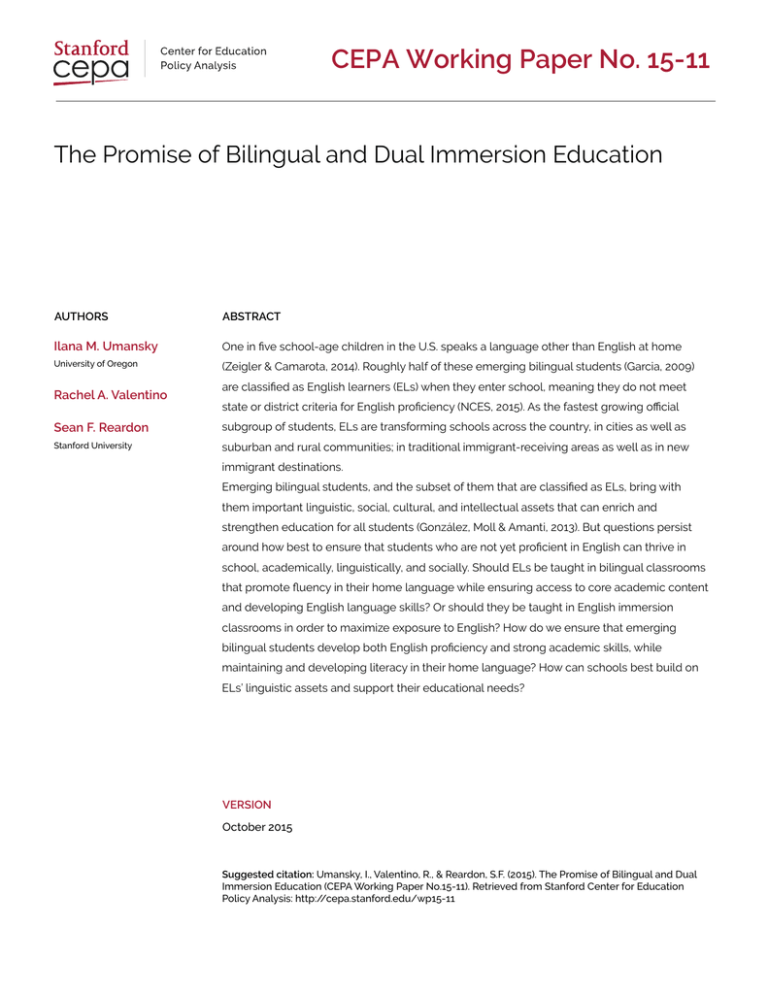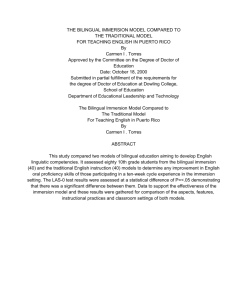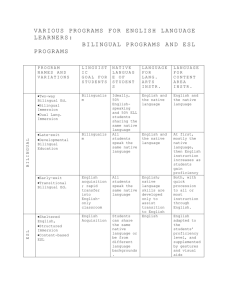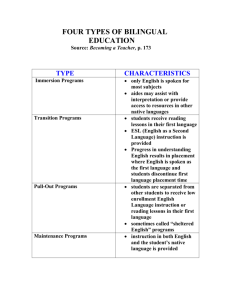CEPA Working Paper No. 15-11 Ilana M. Umansky
advertisement

CEPA Working Paper No. 15-11 The Promise of Bilingual and Dual Immersion Education AUTHORS ABSTRACT Ilana M. Umansky One in five school-age children in the U.S. speaks a language other than English at home University of Oregon (Zeigler & Camarota, 2014). Roughly half of these emerging bilingual students (Garcia, 2009) Rachel A. Valentino are classified as English learners (ELs) when they enter school, meaning they do not meet state or district criteria for English proficiency (NCES, 2015). As the fastest growing official Sean F. Reardon subgroup of students, ELs are transforming schools across the country, in cities as well as Stanford University suburban and rural communities; in traditional immigrant-receiving areas as well as in new immigrant destinations. Emerging bilingual students, and the subset of them that are classified as ELs, bring with them important linguistic, social, cultural, and intellectual assets that can enrich and strengthen education for all students (González, Moll & Amanti, 2013). But questions persist around how best to ensure that students who are not yet proficient in English can thrive in school, academically, linguistically, and socially. Should ELs be taught in bilingual classrooms that promote fluency in their home language while ensuring access to core academic content and developing English language skills? Or should they be taught in English immersion classrooms in order to maximize exposure to English? How do we ensure that emerging bilingual students develop both English proficiency and strong academic skills, while maintaining and developing literacy in their home language? How can schools best build on ELs’ linguistic assets and support their educational needs? VERSION October 2015 Suggested citation: Umansky, I., Valentino, R., & Reardon, S.F. (2015). The Promise of Bilingual and Dual Immersion Education (CEPA Working Paper No.15-11). Retrieved from Stanford Center for Education Policy Analysis: http://cepa.stanford.edu/wp15-11 The Promise of Bilingual and Dual Immersion Education Ilana M. Umansky Rachel A. Valentino Sean F. Reardon Forthcoming in Educational Leadership February 2016 Special Edition “Helping ELLs Excel” This research was supported by grant award #R305A110670 from the Institute for Education Sciences (IES), U.S. Department of Education. The authors are grateful to many individuals at the school district examined in this paper. We refrain for mentioning them by name in order to protect district anonymity but these individuals provided invaluable insights into data features, program characteristics, and interpretation of findings. Any remaining errors are solely those of the authors. 1 The Promise of Bilingual and Dual Immersion Education Introduction One in five school-age children in the U.S. speaks a language other than English at home (Zeigler & Camarota, 2014). Roughly half of these emerging bilingual students (Garcia, 2009) are classified as English learners (ELs) when they enter school, meaning they do not meet state or district criteria for English proficiency (NCES, 2015). As the fastest growing official subgroup of students, ELs are transforming schools across the country, in cities as well as suburban and rural communities; in traditional immigrant-receiving areas as well as in new immigrant destinations. Emerging bilingual students, and the subset of them that are classified as ELs, bring with them important linguistic, social, cultural, and intellectual assets that can enrich and strengthen education for all students (González, Moll & Amanti, 2013). But questions persist around how best to ensure that students who are not yet proficient in English can thrive in school, academically, linguistically, and socially. Should ELs be taught in bilingual classrooms that promote fluency in their home language while ensuring access to core academic content and developing English language skills? Or should they be taught in English immersion classrooms in order to maximize exposure to English? How do we ensure that emerging bilingual students develop both English proficiency and strong academic skills, while maintaining and developing literacy in their home language? How can schools best build on ELs’ linguistic assets and support their educational needs? Over the past several years we have been working closely with staff members in a large California school district to explore these questions. This district uses four different instructional 2 models for EL students, including an English immersion program and three types of programs that combine English instruction with instruction in students’ home language: transitional bilingual, maintenance bilingual, and dual immersion programs. 1 We investigated how EL students fare in these four types of classrooms. In particular, we compared their English proficiency development, academic growth, and reclassification2 rates from kindergarten through middle school. In this article we lay out the arguments for these two main models of EL instruction and summarize the results of our research. Our research shows that EL students in English immersion programs generally have higher English proficiency and standardized academic test scores by second grade than their peers in two-language programs (bilingual and dual immersion programs). By late elementary or middle school, however, these differences are generally eliminated or reversed. By these later grades, ELs who spend their elementary school years in two-language programs have test scores, English proficiency levels, and reclassification rates that are, on average, as high as or higher than similar students who were in English immersion classrooms. We discuss the implications of these findings for educational policy and practice. Competing Theories of English Learner Instruction For several decades there has been a fierce debate over the relative merits of teaching EL students in English versus in a bilingual setting. Some of that debate is ideological and provides no theory- or evidence-based guidance for educators. But some of the debate is grounded in competing hypotheses about what kinds of learning environments are most effective for children 1 Further descriptions of these programs can be found in the Research Context section that follows. EL students are officially “reclassified” from “English Learner” status to “Fluent English Proficient” status once they meet a set of English proficiency and academic criteria. 2 3 learning English. This part of the debate takes as a given that schools in the U.S. have dual responsibilities with respect to ELs: they must help them develop English proficiency (in reading, writing, speaking, and listening) and must provide opportunities for them to develop the same core academic skills and competencies as native English speakers. The debate is about how to best accomplish these two goals. The argument in favor of English immersion instruction claims that English proficiency is a necessary precursor to learning academic skills and content in a school system (and society) in which English is the predominant language. Those in favor of this view argue that it is essential that students learn English quickly, so that they do not fall behind their peers academically. This argument is based on the assumption that English immersion classrooms, because they expose EL students to continuous English language instruction, are the most direct and efficient way to ensure that students develop rapid proficiency in English (Rossell, 2005). In addition to potentially delaying English acquisition, some argue that bilingual programs can isolate EL students and segregate them from native English-speaking peers (Schlossman, 1983), that they are expensive or require specialized teachers and resources that are not always available, and that they are often poorly implemented and supported (Hernandez, 2009). There are several arguments in favor of two-language instructional programs. First is an argument based on hypotheses about how children learn language. Research in cognitive science suggests that language acquisition is partly transferable, so that students who first acquire a strong foundation in one language are better equipped to learn a second language (relative to students who are trying to develop literacy in a second language before they are literate in the first; Genesee, Geva, Dressler, & Kamil, 2008; Cummins, 1979; 2000; Goldenberg, 1996). This is 4 theorized to be because languages share core underlying structures that transfer across languages. This suggests that EL students will develop English skills more effectively if they first have the opportunity—in a bilingual classroom, for example—to develop literacy skills in their home language. Second is the argument that EL students in English immersion classrooms spend too much time early in their schooling in classrooms where they comprehend little of what the teacher says or writes (Auerbach, 1993; Duff, 2001). Students in two-language classrooms, in contrast, can have full access to the academic curricula while learning English because they are taught core academic content in a language they understand. Third is a set of social and societal arguments. Bilingualism (both among students’ whose home language is not English and native English speakers) generates social benefits such as reduced discrimination, improved self-esteem, and stronger cross-group relationships (Wright & Tropp, 2005; Cho, 2000), economic benefits through increased global communication (Callahan & Gándara, 2014), and cognitive health benefits such as lower incidences of Alzheimer’s disease and better executive functioning (Adesope, Lavin, Thompson, & Ungerleider, 2010; Craik, Bialystok, & Freedman, 2010; Bialystok & Martin, 2004; Carlson & Meltzoff, 2008; Soveri, Rodriguez-Fornells, & Laine, 2011). Our research did not test all of these hypotheses, because we did not have data on all the outcomes of interest, such as students’ literacy and proficiency in their home language, postsecondary educational and economic outcomes, nor executive functioning development. Nonetheless, our studies do provide new and relevant evidence on the medium-term academic and English proficiency development of students in four distinct EL programs. 5 Research Context Our research was conducted in a large, urban California school district with a large EL population, comprising roughly 40% of each new Kindergarten cohort. From 2000 to 2012, the time frame of our study, over 40,000 new EL students entered kindergarten in the district. These EL students come from a range of backgrounds, including large Latino and Chinese-origin EL populations. As in many districts across the country, the majority of EL students are children born in the U.S. living in households where a language other than English is spoken. The district of study offered EL students four different instructional program options: English immersion, transitional bilingual, maintenance bilingual, and dual immersion. These programs correspond closely to the four main types of instructional programs for ELs used in school districts across the U.S. The largest program in the school district is the English immersion program, serving 55% of the districts’ incoming ELs. In this program English learners are in general education classes, usually with non-English learner students, in an all-English setting. The English immersion program utilizes instructional methods designed to help non-proficient English speakers access curricular content. This teaching approach, called SDAIE (Specially Designed Academic Instruction in English), includes practices including multisensory experiences such as labs and demonstrations, comprehensible input including graphical organizers and a focus on academic language, and frequent formative assessment to see how students are faring (Cline & Necochea, 2003). Teachers in the English immersion program have received professional preparation to use these methods. 6 The other three programs are different forms of bilingual instruction. First is a transitional bilingual program, which is designed exclusively for emerging bilingual students and aims for relatively rapid transition into English instruction, typically by 3rd grade. This program uses instruction in students’ home language as a bridge to English acquisition and as a way of making content area instruction more accessible. Second is a maintenance bilingual program, which also exclusively enrolls emerging bilingual students but is longer in duration (through 5th grade or longer) than the transitional bilingual program. It has as a goal full bilingualism and biliteracy in English and the students’ home language. Third is a dual immersion program. This program, unlike the prior two, targets enrollment of both emerging bilingual students and students who speak only English, typically in a 1:1 or 2:1 ratio. Like the maintenance program, the district’s dual immersion program runs at least through the end of elementary school, in some cases extending into middle and high school. The goal of dual immersion is that both ELs and native English speakers become bilingual and biliterate in both languages. Research Design and Data We analyzed data on 8 cohorts of English learner students who were each assigned to one of the four different EL instructional programs, using up to 10 years of data for each cohort. We compared demographically similar students who were enrolled in different programs by statistically controlling for students’ background characteristics. We also took advantage of the fact that, in some cases, more families requested specific programs than the number of seats 7 available. In such cases, the district’s school and program assignment policy relied partially on random assignment of students into programs. Although the study is not based on a true randomized controlled trial (RCT), our ancillary analyses suggest that our comparisons are a good approximation to those from a true RCT. In comparing students in the different programs, we examined three different outcomes: students’ English language acquisition (as measured by their performance on the California English Language Development Test - the CELDT); their academic performance and growth (as measured by their performance on the California Standards Tests – CST in mathematics and English language arts); and their reclassification from English learner status to “reclassified fluent English proficient” (RFEP) status. Research Findings English Acquisition 3 We found that the large majority of EL students reached English proficiency by middle school, regardless of the type of instructional program they were in (Figure 1). The left panel of Figure 1 shows the cumulative proportion of EL students who reach English proficiency, as measured by California’s standardized English proficiency assessment (the CELDT), in each of the four EL programs, by each grade level from 2nd to 7th grade. In all programs over 80% of ELs are proficient in English by the end of elementary school and over 90% of ELs are proficient by the 7th grade. Despite these common patterns, EL students in each of the programs reached English 3 The analyses presented here and in the section on reclassification are detailed in Umansky and Reardon (2014). These results differ from the ones depicted in that paper in two ways: first, the results here are based on all EL students, rather than just Latino EL students; second, the estimates here are based on statistical models that control for parents’ preferences about what kind of instructional program they preferred. These estimates were described in Umansky and Reardon (2014), but were not shown graphically. 8 proficiency at different rates. In the bilingual and dual immersion models (which we refer to collectively as two-language programs), EL students take slightly longer, on average, than similar EL students in English immersion to become proficient in English. The gap between English proficiency rates in English immersion and two-language programs exists in mid-elementary school grades. By the time students reach 5th grade, English proficiency rates are basically identical across programs. By 7th grade, slightly more students in the maintenance bilingual (95%) and dual immersion (94%) programs reach proficiency compared to the English immersion and transitional bilingual programs (both 92%). Reclassification Rates The right panel of Figure 1 shows the cumulative proportion of EL students who are reclassified out of EL status, by EL program and grade, for grades 2 to 7. Reclassification is an important milestone for English learner students; reclassified students are no longer a protected class of students and do not receive specialized services. In the district examined here EL students must meet English proficiency as well as academic benchmarks in order to be reclassified. Because of the academic criteria, reclassification rates are slightly lower than English proficiency rates. Here again we see that EL students in the different programs have significantly different reclassification trends. EL students in the English immersion and transitional bilingual programs are reclassified at higher rates in elementary school. The pace at which additional students are reclassified slows in all programs, but most acutely in English immersion, resulting in very similar reclassification rates across English immersion and the two-language programs by the 7th grade. In that grade reclassification is highest in the transitional bilingual program (92%), 9 followed by the other three programs in quick succession: English immersion (88%), maintenance bilingual (87%), and dual immersion (86%). Figure 1 Estimated Cumulative Percent of EL Students Reaching English Proficiency and Reclassification, by Instructional Program Academic Growth in English Language Arts and Mathematics Academic achievement trajectories of EL students also vary across instructional programs. Figure 2 shows EL students’ average achievement growth on English language arts (ELA) and math tests (as measured by California’s standardized tests), by EL program, relative to the statewide average growth rate for all students (the plain dashed line at 0). Two patterns are evident in Figure 2: first, by 2nd grade, ELs who enter the district in kindergarten and enroll in the transitional bilingual program have higher ELA and math scores, on average, than their similar peers who enrolled in other types of programs. Students in dual immersion programs, in contrast, have scores that are generally lower than their counterparts in 10 other programs. If we cared only about short-term program effectiveness, these findings would suggest that transitional bilingual programs are more effective at developing academic skills in English than other programs, while dual immersion programs are the least effective. The second finding evident in Figure 2 is that academic trajectories over the longer-term, however, reveal a different pattern (see Valentino & Reardon, 2015). ELs in dual immersion programs develop ELA skills much faster than those in English immersion. By 7th grade, dual immersion students’ scores have surpassed those of students in English immersion and maintenance bilingual programs and are not statistically different from those of students in the transitional bilingual program. In this district then, dual immersion and transitional bilingual programs appear more effective at promoting longer-term development of ELA skills than do English immersion and maintenance bilingual programs. The longer-term trajectories of average math scores do not differ as much across EL instructional programs. The math scores of ELs in maintenance bilingual programs grow at a modestly slower pace than those of students in the other three programs. By 6th grade, the math scores of ELs in all programs are roughly similar, with the exception of transitional bilingual programs, where students score moderately higher than similar EL students who began school in the other programs. 11 Figure 2. Estimated average English Language Arts (ELA) and Math achievement trajectories relative to the state average: EL kindergarten entrants, by instructional program Math ELA 0.4 0.4 Initial EL Program Transitional Bilingual English Immersion 0.3 0.3 Maintenance Bilingual Dual Immersion 0.2 State Average Standardized Math Score (State Average = 0) Standardized ELA Score (State Average = 0) 0.2 0.1 0.0 -0.1 0.1 0.0 -0.1 -0.2 -0.2 -0.3 -0.3 2nd 3rd 4th 5th 6th 7th 2nd 3rd Grade 4th 5th 6th 7th Grade What Does This Mean for Schools and Districts? When possible, invest in high-quality two-language programs Taken together, Figures 1 and 2 suggest that by the time students are in middle school, ELs assigned to two-language programs are generally doing as well as or better than comparable students assigned to English immersion programs across academic, English proficiency, and reclassification outcomes. In some cases the benefits of two-language instruction are small or negligible. In others, they are quite large; for example, ELs in some two-language programs make academic gains that are as much as 0.3 standard deviations larger from grades 2 through 7 than their peers in English immersion. These benefits of two-language instruction may have important 12 implications for closing the achievement gap between ELs and non-ELs. In combination with existing evidence on the impact of two-language instructional programs on home language outcomes (Slavin, Madden, Calderón, Chamberlain & Hennessy, 2011) and the evidence of the social, health, and economic benefits of bilingualism (Adesope, Lavin, Thompson, & Ungerleider, 2010; Bialystok, 2011; Callahan & Gándara, 2014), these findings make a compelling argument for investment in high-quality two-language instructional programs. Choose among two-language programs based on community and stakeholder voice Each of the two-language models we studied appears to have positive effects for students in some domains, and at a minimum, none appear detrimental relative to English immersion programs. Because the number of students in some programs was modest, and because of differences among the implementation of programs across schools, our research cannot definitively determine the relative effectiveness of the three types of two-language programs. In the district we studied, each appears to promote at least one type of positive outcome for EL students. This suggests that schools and districts would benefit from developing two-language programs that meet the unique needs of EL students and the interests of the communities they serve. Some communities and stakeholders may prefer dual immersion programs, which serve both EL and English proficient students, while others may value the indepth support of EL students in maintenance bilingual programs, or the relatively rapid integration of EL students in a transitional bilingual program. 13 Slow and steady EL students are learning many things at once: academic content, English, and in twolanguage programs, their home language. Our findings suggest that ELs can and do succeed in all three areas but they need time to do so. Rather than pushing ELs to reach English language benchmarks rapidly and withholding academic (or other) instruction or content until they do, attention should be focused on providing high-quality teaching and full, meaningful access to content in all EL programs, regardless of language of instruction. Take the long view Schools and districts should avoid evaluating EL programs by tracking students for only a year or two and only on a single outcome. Longitudinal evaluations that trace students through elementary and into middle and high school using a variety of outcome measures can be far more informative. In our study, a short-term evaluation would have led to the conclusion that the more intensive two-language programs were not as effective as the English immersion and transitional bilingual programs. In the medium term (by middle school), however, ELs in these programs generally catch up and perform at least as well as, if not better than, their peers in English immersion on assessments of English proficiency and academic skills. Ideally, given the value of bilingualism, evaluations of the effectiveness of EL instructional programs would also measure students’ language proficiency and literacy in their home language. 14 Conclusion As the population of EL students grows, and with it a growing understanding of both the rich assets these students have and the ways in which they are currently struggling in school, it is important that school leaders and teachers have access to good information about the most effective instructional programs for ELs. We hope our research contributes to the body of evidence available to educators. Our research shows that two-language instructional programs can be very effective for emerging bilingual students acquiring English. In English proficiency, reclassification patterns, and academic growth, EL students in these programs show equivalent or superior outcomes to comparable students in English immersion programs. Based on this, we suggest that states and school districts use their resources to develop and support high-quality two-language programs that meet the needs of their students and communities. 15 References Adesope, O. O., Lavin, T., Thompson, T., & Ungerleider, C. (2010). A systematic review and metaanalysis of the cognitive correlates of bilingualism. Review of Educational Research, 80(2), 207-245. Auerbach, E. R. (1993). Reexamining English only in the ESL classroom. TESOL Quarterly, 9-32. Bialystok, E. (2011). Reshaping the mind: The benefits of bilingualism. Canadian Journal of Experimental Psychology/Revue canadienne de psychologie expérimentale, 65(4), 229235. Bialystok, E., & Martin, M.M. (2004). Attention and inhibition in bilingual children: Evidence from the dimensional change card sort task. Developmental Science, 7, 325-339. Callahan, R., & Gándara, P. (2014). Bilingual advantage: Language, literacy, and the labor market (R. Callahan & P. Gándara Eds.). Clevedon, UK: Multilingual Matters. Zeigler, K., & Camarota, S.A., (2014). One in five U.S. residents speaks foreign language at home, Record 61.8 million: Spanish, Chinese, and Arabic speakers grew most since 2010. Center for Immigration Studies, Washington, D.C. Carlson, S.M., & Meltzoff, A.N. (2008). Bilingual experience and executive functioning in young children. Developmental Science, 11, 282-298. Cho, G. (2000). The role of heritage language in social interactions and relationships: Reflections from a language minority group. Bilingual Research Journal, 24(4), 369-384. Cline, Z., & Necochea, J. (2003). Specially designed academic instruction in English (SDAIE): More than just good instruction. Multicultural Perspectives, 5(1), 18-24. Craik, F.I.M., Bialystok, E., & Freedman, M. (2010). Delaying the onset of Alzheimer disease: 16 Bilingualism as a form of cognitive reserve. Neurology, 75, 1726-1729. Cummins, J. (1999). Alternative paradigms in bilingual education research: Does theory have a place? Educational Researcher, 28, 26-32. Cummins, J. (2000). Language, power, and pedagogy: Bilingual children in the crossfire. Clevedon, UK: Multilingual Matters. Duff, P. (2001). Language, literacy, content, and (pop) culture: Challenges for ESL students in mainstream courses. Canadian Modern Language Review, 58(1), 103-132. Garcia, O. (2009). Emergent Bilinguals and TESOL: What's in a Name? TESOL Quarterly, 43(2), 322-326. Gardner, R. C., & Lambert, W. E. (1972). Attitudes and Motivation in Second-Language Learning. Genesee, F., Geva, E., Dressler, C., Kamil, M.L. (2008). Cross-linguistic relationships in secondlanguage learners. In. D. August & T. Shanahan (Eds). Developing reading and writing in second-language learners: Lessons from the report of the national literacy panel on language-minority children and youth. (61-93). Mahwah, NJ: Lawrence Earlbaum Associates. Goldbenberg, C. (2008). Teaching English language learners. What the research does and does not say. American Educator. Summer 2008. 8-44. Goldenberg, C. (1996). The education of language-minority students: Where are we, and where do we need to go? The Elementary School Journal, 96, 353-361. González, N., Moll, L. C., & Amanti, C. (2013). Funds of knowledge: Theorizing practices in households, communities, and classrooms: Routledge. Greene, J.P. (1998). A meta-analysis of the effectiveness of bilingual education. Claremont, CA: 17 Thomas Rivera Policy Institute. Hernandez, E. M. (2009). The effects of proper implementation of bilingual programs in elementary schools in the United States. In M. S. Plakhotnik, S. M. Nielsen, & D. M. Pane (Eds.), Proceedings of the Eighth Annual College of Education & GSN Research Conference (pp. 62-68). Miami, FL: Florida International University. Lindholm-Leary, K., & Borsato, G. Academic achievement. In F. Genesee, K. Lindholm-Leary, & D. Christian. Educating English language learners. (176-211). New York, NY: Cambridge University Press. National Center for Education Statistics (NCES, 2015). The condition of education 2015 (NCES 2015-144). English Language Learners. U.S. Department of Education. Rossell, C. (2005). Teaching English through English. Educational Leadership, 62(4), 32-36. Schlossman, S. (1983). Self Evident Remedy? George I. Sanchez, Segregation, and Enduring Dilemmas in Bilingual Education. The Teachers College Record, 84(4), 871-907. Slavin, R., Madden, N., Calderón, M., Chamberlain, A., & Hennessy, M. (2011). Reading and language outcomes of a multiyear randomized evaluation of transitional bilingual education. Educational Evaluation and Policy Analysis, 33(1), 47-58. Soveri, A., Rodriguez-Fornells, A., & Laine, M. (2011). Is there a relationship between language switching and executive functions in bilingualism? Introducing a within group analysis approach. Frontiers in Psychology, 1. Umansky, I. M., & Reardon, S. F. (2014). Reclassification patterns among Latino English learner students in bilingual, dual immersion, and English immersion classrooms. American Educational Research Journal, 51(5), 879-912. 18 Valentino, R.A., & Reardon, S.F. (2015). Effectiveness of four instructional programs designed to serve English learners. Variation by ethnicity and initial English proficiency. Educational Evaluation and Policy Analysis. Available online first at http://epa.sagepub.com/content/early/2015/04/01/0162373715573310.abstract Wright, S. C., & Tropp, L. R. (2005). Language and intergroup contact: Investigating the impact of bilingual instruction on children’s intergroup attitudes. Group Processes & Intergroup Relations, 8(3), 309-328. 19






